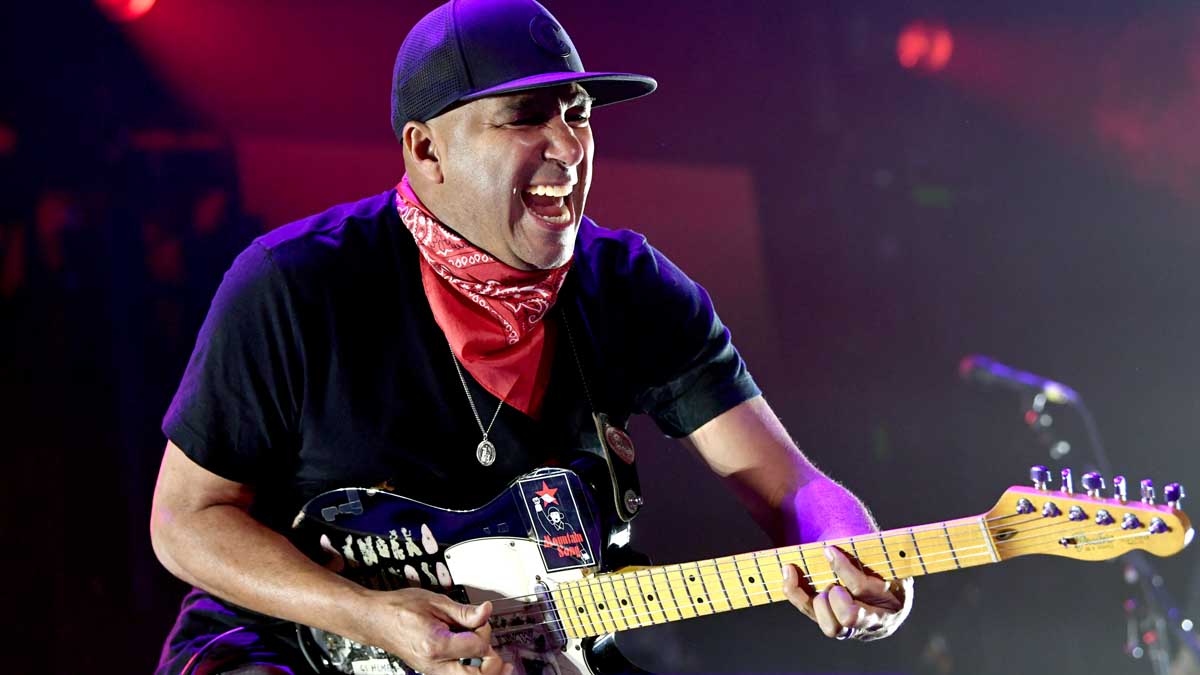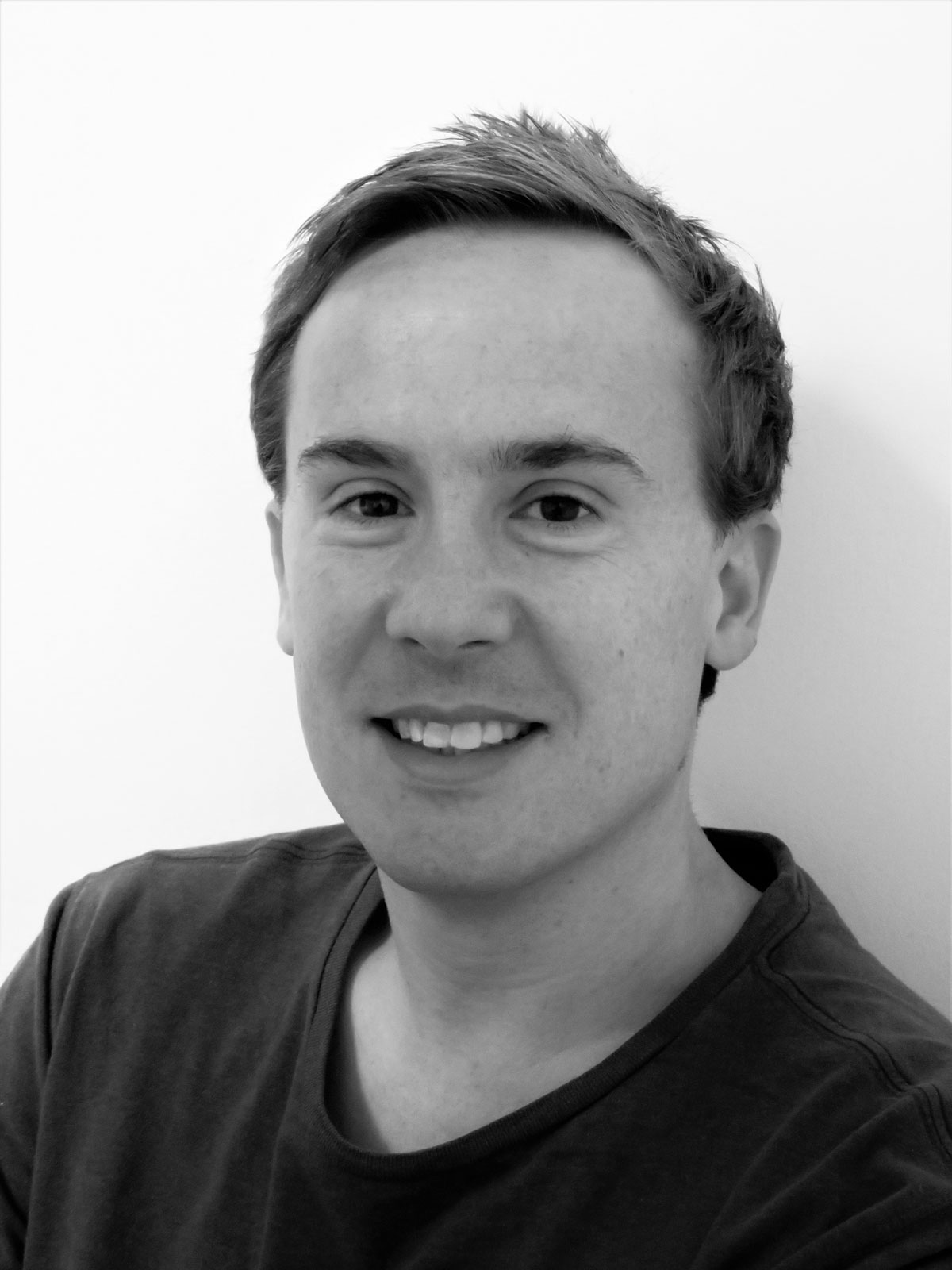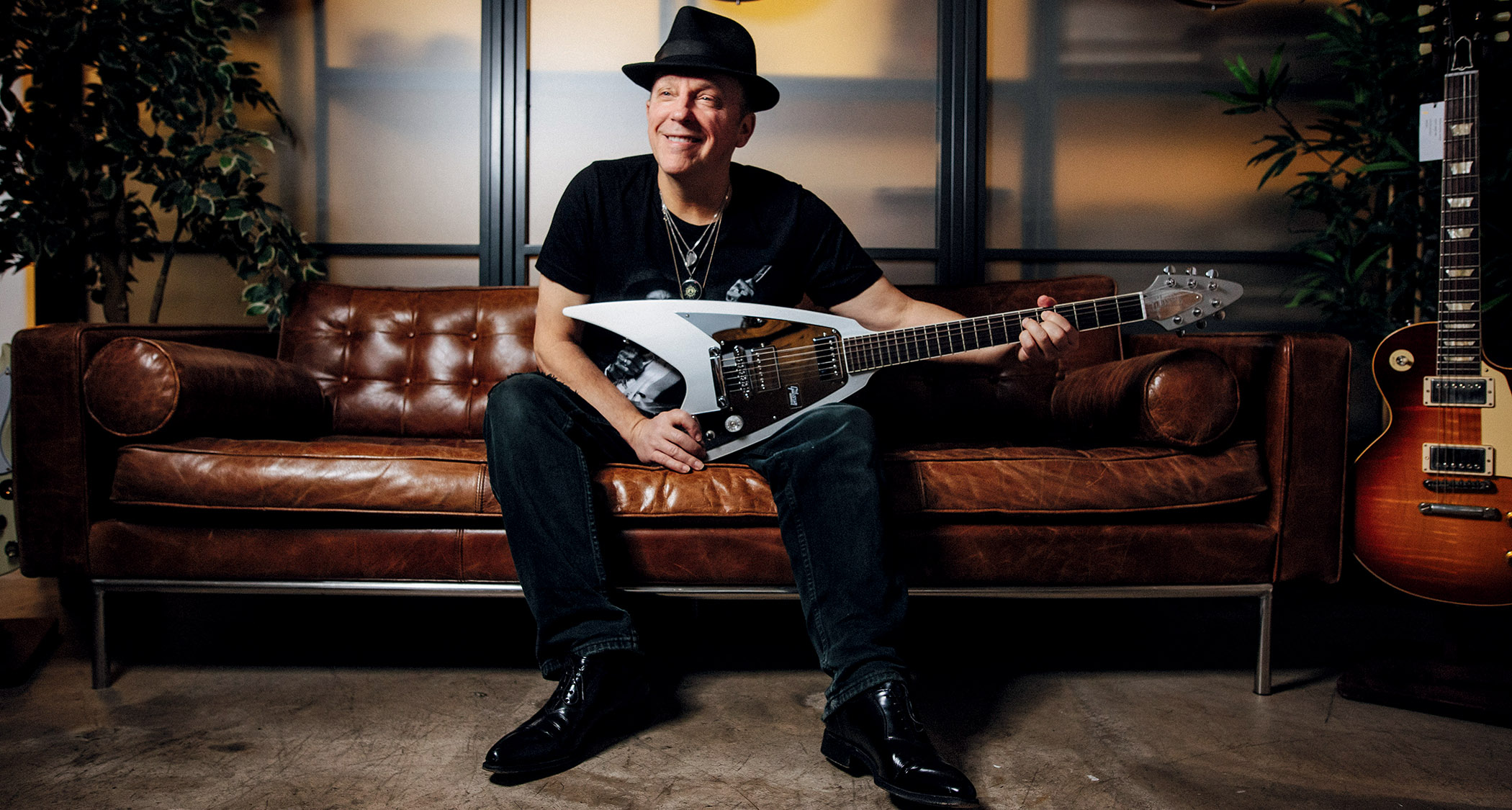Tom Morello: “Trust me, there are plenty of new guitar sounds still to discover. I guarantee you that“
Rage Against the Machine's six-string revolutionary looks back at his life and career in his own words

He’s the Harvard alumnus, political activist and eternal square peg whose sonic adventurism with Rage Against The Machine and Audioslave tore up the rules of electric guitar.
Now, as Tom Morello releases a new photobook spanning his three-decade career, he shares memories of obsessive practice, bad gigs and nights behind bars…
Kid Rock
“As a kid, I had a little acoustic guitar that I probably plucked Smoke On The Water on. But at that age, I had no ambitions beyond jumping around on the sofa with it. Then, at 15, I had a couple of guitar lessons that didn’t really take because they wanted to teach me how to tune the guitar and play the B major scale – and I wanted to learn Black Dog and Detroit Rock City. But from 19 years old, I became obsessive-compulsive. Guitar felt like a religious calling. It bordered on some kind of mental disorder. I couldn’t not do it. It was a compulsion that steered my life.”
High Flyer
“In my high-school band, we practised so hard to play Born To Be Wild for a battle of the bands. When we got on stage, the piano player played the wrong chords, the bass player came in on the wrong note – it was a very inauspicious beginning to my musical career.
Cheap guitars can be great. I mean, my ‘Creamy’ guitar cost $40, and that – through a 20-watt solid-state Marshall practice amp – won Rage our first Grammy for Tire Me
“But we were on a riser. And so when the chorus came in I leapt off the riser – and the place went apeshit. It was like, ‘We’ve spent four months learning the song but what we should have been practising is jumping up and down.’ It was a lesson I haven’t forgotten. I always had that track-and-field background, and for some reason, from early on I could always play guitar while aloft.”
Cheap Thrills
“I had a bad experience when I bought my first $50 Kay. The sales rep was mocking me, saying the action was ridiculously high – ‘but I guess you’re not gonna play very extensive leads anyway, are you?’ I had more than one chip on my shoulder but that stuck with me.
“That Kay was my main guitar until I got a Gibson Explorer. Then it sat for 30 years at my mom’s house in Illinois. Until one day, I sat bolt-upright in bed, went back to Illinois, got that Kay, gave it to my tech and said, ‘Let’s see what we got here.’ I actually used it on The Atlas Underground [2018]. Cheap guitars can be great. I mean, my ‘Creamy’ guitar cost $40, and that – through a 20-watt solid-state Marshall practice amp – won Rage our first Grammy for Tire Me.”
All the latest guitar news, interviews, lessons, reviews, deals and more, direct to your inbox!
Hard & Fast
“When my friends began loving punk-rock, leaving behind their Spandex and heavy metal, I still wanted to have one foot firmly in both worlds. I never gave up Sabbath, Maiden, Priest, the Yngwies and Vais – while at the same time, embracing the rawness of punk.
“You know, The Clash is my favourite band of all time. And Joe Strummer, as far as guitar players go, is both the greatest and someone who could barely play, to the standards of the readers of Guitarist magazine. In rock ’n’ roll, it’s much more about the spirit of what you’re doing, rather than the technical ability. But I wanted to have both.”
Up All Night
“Studying at Harvard while playing rock ’n’ roll was challenging. It was a pretty significant jump in workload and brain bandwidth. And then, added to that, was my obsessive-compulsive practice regimen. I would finish my studies at two in the morning then practise until 6am, like it was nothing. Just alone in a stairwell, day after day.
“It did not necessarily help with my social skills, relationships or job opportunities. In my four years at Harvard, I maybe missed two days of practice, through some really debilitating sickness. And then I felt really guilty about missing those two days!”
Hair Today, Gone Tomorrow
“Moving to Los Angeles in the 80s was dreary. I’m a real type-A personality, so I was like, ‘I’m gonna put together a band with neo-Marxist politics and Black Sabbath riffs.’ I put an ad in the paper to that effect and my phone was not exactly ringing off the hook.
That underground scene introduced me to the idea that you could match heavy riffs with intelligent lyrics and imagery, and not be ashamed
“I thought I was gonna move out there and it was gonna be a world of Steve Vais and Yngwie Malmsteens. But it was all about this very particular image. It was the height of Faster Pussycat and the Sunset Strip bands. No-one wanted to play with me. I remember making plans to jam with some metal band but before it happened their manager called to ask, ‘First of all, how long is your hair? Not that long? Then we’re not interested.’”
Going Underground
“What I didn’t know was that there was this underground LA scene bubbling up, with bands like Jane’s Addiction and the Red Hot Chili Peppers, that had a very different aesthetic. I joined a band called Lock Up, who didn’t care how long my hair was, they just thought I was a ripping guitar player.
“That underground scene introduced me to the idea that you could match heavy riffs with intelligent lyrics and imagery, and not be ashamed. So when Lock Up broke up, I was determined to never play the game and never write or play a note of music I didn’t absolutely believe in.”
Square Pegs
“I was fortunate, in Zack De La Rocha [vocals], Brad Wilk [drums] and Tim Commerford [bass], to find musicians who felt the same as me. That had no commercial ambitions whatsoever. There was no hope of a record deal. There were no bands playing in clubs that looked like us, you know, a militant Chicano rapper, a half-black guitar-shredding guy, a Jewish drummer and an Orange County weightlifting bassist.
“And so we made the music for that first Rage Against The Machine record in total innocence. We rehearsed at this industrial park in the San Fernando Valley, and I remember the first person we ever played for was this guy who worked down there. He sat down, we played him four songs, and afterwards he stood up and said, ‘Your music makes me want to fight!’”
Sound & Vision
“In the earliest days of Rage, I was still practising eight hours a day, you know, full-on Randy-Rhoads-poster-on-the-wall kind of shredding. Then we played some worthless college gig, opening up for two cover bands and they both had a shredding guitar player.
“I was watching these two guys soundcheck and I thought, ‘Well, there doesn’t need to be a third.’ So during my eight hours, I began practising the eccentricities in my playing, experimenting with the toggle switch – or if I made a mistake repeating that mistake 16 times and making it the cornerstone of the song.
“With some of my Rage solos, there is technique involved. I still had my 80s gunslinger mentality tucked away in there somewhere, you know, to be the fastest draw. But it was much more a matter of imagination and creativity than technical ability.”
Step On It
“I’ve been accused countless times of using a ton of effects – but I’ve used the same four pedals for the last 30 years. It’s a wah, a Whammy, a delay and a phaser. It’s just about finding different applications for the same old shit.
“The electric guitar is a relatively new instrument on the planet. It’s just a piece of wood, with six strings, a few electronics. But you can manipulate it. As soon as I had that revelation in Rage, it was like, ‘I’m the DJ in the band but rather than sampling I’m gonna use my bare hands to create this new vocabulary for the electric guitar.’
“My influences were Dr Dre, Jam Master J and a trip to the zoo, you know? So the combo of the big, heavy Sabbath-Zeppelin riffs, with this otherworldly R2-D2 stuff, it really felt like I’d found my voice on the instrument. There was no-one else in that lane.”
Take The Power Back
“I’ve been arrested four times for civil disobedience. The feeling evokes what it might have been like to be in jail in Martin Luther King’s time, where you’re singing songs with your comrades, and you’re on a mission, and you knew that morning that you were gonna be in jail that night.
“Rage’s protest gig outside the Democratic National Convention in 2000 was really hairy. It felt like we could all die. There were tens of thousands of people hemmed in and the police gave everyone a five-minute warning to disperse – then attacked the crowd after about 30 seconds. My girlfriend, who’s now my wife, got hit with a baton. We were trying to get out with our lives, you know?”
Sonic Boom
“We were very fortunate with Audioslave. It was our collective belief that for a band to find its greatness, it has to be authentic. When Tim, Brad and I originally formed Audioslave with Chris Cornell in 2001, it was my intention that it would be even more political than Rage.
“But it soon became clear that wasn’t the direction we wanted to go. The principal difference between Rage and Audioslave is not politics. The music in Rage is very James Brown and hip-hop-based – it all comes back to the ‘1’. In the entire catalogue of four Rage Against The Machine albums, there might be zero chord changes.
“It’s relentless. But with Audioslave, to provide Chris with the harmonic interplay that would allow him to weave great melodies, we had a very different sonic palette. You know, songs like I Am The Highway, Like A Stone or Be Yourself were chord based. That pushed us and made for three exciting records.”
American Graffiti
“The guitar is just another canvas to express yourself. I had already painted four cute little hippos onto one of my guitars. Then just before Rage played our first headline club gig at the Whisky A Go Go, I was sat there on my floor and I scrawled ‘Arm The Homeless’ onto it. To me, it’s the juxtaposition of these happy floating hippopotami and this kind of situationist, outrageous screed written on the guitar.
“It represented pretty well who I am. That writing has been on there 30 years. In a way, a guitar is a divining rod to bring down truths from the heavens. And I needed a different divining rod for Audioslave, and that was the ‘Soul Power’ Strat. I customised the toggle switch, the pickups, the whammy bar – and it reflected the change.”
Folk You, I Won’t Do What You Tell Me
“I’ve always been drawn to heavy music. First it was metal, then it was punk, then it was hardcore hip-hop. But I discovered folk music late and when I did it was early Dylan records, Springsteen’s Nebraska, Woody Guthrie, stuff like that.
“And I realised that folk music is the heaviest of all, because the right couplet, matched with the right minor chord, can keep you up five nights in a row. In order to convey what I want to as the agitprop folk troubadour in The Nightwatchman, that’s going to require an acoustic guitar. That’s still a very important part of my musical life.”
Sky’s The Limit
“Trust me, there are plenty of new guitar sounds still to discover. I guarantee you that. I got new shit coming and there’s some pretty crazy guitar tones. It’s a lifelong quest to expand the boundaries of what I consider the greatest instrument ever invented, which is the electric guitar.
There is nothing – nothing – in the history of live or recorded music like the sound of a distorted electric guitar and the beat dropping with it
“While musical trends come and go, and while guitar music ebbs and flows on the charts, there is nothing – nothing – in the history of live or recorded music like the sound of a distorted electric guitar and the beat dropping with it. There’s great music of many other kinds – country, classical, jazz and hip-hop. But there’s nothing that approximates that adrenaline surge.”
Turning The Page
“When I look through my new photobook, Whatever It Takes, it reminds me of what a crazy mosaic my career has been. It’s like this bizarre quilt of rock ’n’ roll and political activism, with Rage, Audioslave and gigs with Springsteen, bad outfits and picket lines. To me, it’s just my life and I live it day by day. But when you assemble it all into one tome – it’s kind of staggering, you know?”
- Tom Morello's new photobook, Whatever It Takes, is out now through Genesis Publications.
Henry Yates is a freelance journalist who has written about music for titles including The Guardian, Telegraph, NME, Classic Rock, Guitarist, Total Guitar and Metal Hammer. He is the author of Walter Trout's official biography, Rescued From Reality, a talking head on Times Radio and an interviewer who has spoken to Brian May, Jimmy Page, Ozzy Osbourne, Ronnie Wood, Dave Grohl and many more. As a guitarist with three decades' experience, he mostly plays a Fender Telecaster and Gibson Les Paul.




